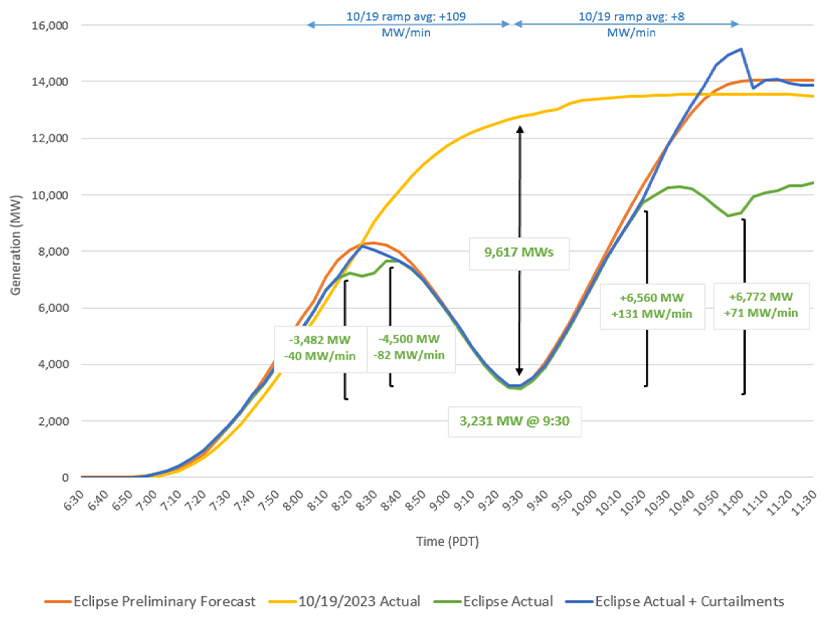The partial solar eclipse of Oct. 14, 2023, knocked 4,500 MW of solar generation off the CAISO grid — about 1,000 MW more than the reduction seen during the August 2017 total eclipse.
The partial solar eclipse of Oct. 14, 2023, knocked 4,500 MW of solar generation off the CAISO grid — about 1,000 MW more than the solar-power reduction seen during the August 2017 total eclipse, according to a recent report.
The result was expected given the increase since 2017 in grid-scale solar, which accounted for 16,500 MW in 2023 compared with 10,000 MW in 2017.
“The growth in solar generation since 2017 exacerbated the eclipse’s effects,” CAISO said in the report, which details system and market performance during the Oct. 14 event.
The Oct. 14 eclipse lasted from about 8 a.m. to 11 a.m. in California, with a maximum impact around 9:30 a.m. As output from behind-the-meter rooftop solar dropped, load grew by 2,064 MW from 8:25 a.m. to 9:20 a.m., peaking at about 21,000 MW, the report said.
Similar to the response in August 2017, CAISO called on other resources to make up for the loss of solar generation on Oct. 14, including gas-fired plants, hydropower and imports. (See Grid Operators Manage Solar Eclipse.)
But the Oct. 14 response included a sizable contribution from storage resources, which supplied about 1,500 MW of capacity in real-time. Storage resources also boosted regulation capacity.
“Battery storage resources, which have increased dramatically in the ISO in the past three years, played a role in offsetting the eclipse’s effects,” the report said.
Another difference between the 2017 and 2023 eclipses is that participation in CAISO’s Western Energy Imbalance Market (WEIM) has grown, from four entities in addition to CAISO in August 2017 to more than 20 entities in 2023. WEIM participants have access to a greater diversity of energy supply.
“During the eclipse, the WEIM proved to be an effective mechanism to manage conditions throughout its Western footprint by determining optimal transfers in its areas when those transfers were needed most,” CAISO said in its report.
The CAISO grid remained stable during the eclipse, and system operations returned to normal soon after it was over. (See Eclipse Barely Dims CAISO Operations.)
Steep Ramp-Up
During the partial, or annular, eclipse on Oct. 14, the moon obscured the sun by 65% to 90% within WEIM territory. Because the eclipse was on a Saturday, load was lighter than it might have been on a weekday.
The total eclipse of Aug. 21, 2017, was on a Monday and lasted from about 9 a.m. to noon in California.
On the morning of Oct. 14, solar production reached 7,731 MW before the eclipse slashed it to 3,231 MW, a drop of 4,500 MW. During the August 2017 eclipse, solar generation fell by 3,547 MW, from 6,392 MW to 2,845 MW.
In a preeclipse technical bulletin issued in late August, CAISO expressed concern about the steep ramp-up of solar generation that was expected as the eclipse waned. (See CAISO Sheds Light on October Solar Eclipse Preparations.)
From 9:30 a.m. to 11 a.m. on Oct. 14, the average ramp-up was 71 MW per minute, compared to 8 MW per minute over the same time during a non-eclipse, full-sun day. Between 9:30 a.m. and 10:20 a.m., the post-eclipse ramp-up was even steeper at 131 MW per minute.
Solar curtailment was negligible from 9 a.m. to 10 a.m., then spiked between 10 a.m. and noon before returning to normal levels.
CAISO noted that parts of California were cloudy on the morning of Oct. 14, lessening eclipse impacts compared to modeling based on clear-sky conditions.
Extensive Preparation
In addition to its pre-eclipse technical bulletin and modeling of expected impacts, CAISO reached out to WEIM participants and other entities ahead of time.
According to the new report, other preparations included:
-
- Charging storage resources ahead of time;
- Additional procurement of day-ahead commitment capacity;
- Additional procurement for regulation; and
- Tighter control bands to balance the system in real time.
CAISO increased its volume of exceptional dispatches in the hours before the eclipse to make sure battery resources had sufficient state of charge and that other generating resources were available to provide ramping capacity.
CAISO released the eclipse performance report last month and discussed findings during a Dec. 14 market performance and planning forum.
Lessons learned from the Oct. 14 event can be applied to the next eclipse: a total solar eclipse on April 8, CAISO staff said during the forum.
The total eclipse path through the U.S. will extend from Texas to Maine, with fewer impacts expected on the West Coast.

